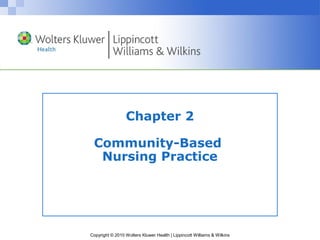More Related Content
Similar to community based nursing practice
Similar to community based nursing practice (20)
More from Kalinga Institute of Medical Sciences
More from Kalinga Institute of Medical Sciences (20)
community based nursing practice
- 2. Factors that Have Increased the Need for
Community Health Care
• Changes in federal legislation
• Tighter insurance regulations
• Decreasing health revenues
• Alternative health care delivery systems
Copyright © 2010 Wolters Kluwer Health | Lippincott Williams & Wilkins
- 3. Primary Concepts of Community-Based
Care
• Promotion of self-care
• Preventive care within content of community, culture
• Continuity of care
• Collaboration
Copyright © 2010 Wolters Kluwer Health | Lippincott Williams & Wilkins
- 4. Question
• The shift in health care delivery from acute care to
community based case is primarily the result of
A.alternative health care delivery systems.
B.insurance regulations changes.
C.federal legislation changes.
D.combination of these three items.
Copyright © 2010 Wolters Kluwer Health | Lippincott Williams & Wilkins
- 5. Answer
• D. Combination of alternative health care delivery
systems, insurance regulations changes, federal
legislation changes
• Rationale: Changes in federal legislation, tighter
insurance regulations, decreasing hospital revenues, and
alternative health care delivery systems all have affected
the ways in which health care is delivered.
Copyright © 2010 Wolters Kluwer Health | Lippincott Williams & Wilkins
- 6. Levels of Preventive Care
• Primary
• Secondary
• Tertiary
Copyright © 2010 Wolters Kluwer Health | Lippincott Williams & Wilkins
- 7. Community Health Settings
• Public health departments
• Various clinics
• Industrial, occupational nursing
• School nursing
• Home health care
Copyright © 2010 Wolters Kluwer Health | Lippincott Williams & Wilkins
- 8. Home Health Care
• Becoming one of largest areas of practice for nurses
• Collaborative, interdisciplinary
• Holistic
Copyright © 2010 Wolters Kluwer Health | Lippincott Williams & Wilkins
- 9. Community Nursing Differs from Hospital-
Based Nursing
• Community nurses care for individuals, families, groups
outside hospital setting
• Nurse is guest coming into patient home or community
setting
• Nurse may provide
– Direct care
– Resources or advocacy to larger group in community
setting
Copyright © 2010 Wolters Kluwer Health | Lippincott Williams & Wilkins
- 10. Community Nursing
• Nurses have little control over care environment
• Little on-site support or supervision available
• Supplies, resources may not be available
Copyright © 2010 Wolters Kluwer Health | Lippincott Williams & Wilkins
- 11. Nurses Functioning in the Community
Must
• Be
– Self-directed
– Flexible
– Critical thinkers
– Independent decision makers
– Culturally competent
Copyright © 2010 Wolters Kluwer Health | Lippincott Williams & Wilkins
- 12. Nurses Functioning in the Community
Must (cont’d)
• Have
– Basic nursing care competencies
– Excellent assessment skills
– Good abilities to provide health education
Copyright © 2010 Wolters Kluwer Health | Lippincott Williams & Wilkins
- 13. Question
• Tell whether the following statement is true or false:
• A common element of a nurse working in community-
based case is the focus on the needs of the individual.
Copyright © 2010 Wolters Kluwer Health | Lippincott Williams & Wilkins
- 14. Answer
• False.
• Rationale: A common element in all the roles of the nurse
working in community-based care is the focus upon
community needs as well as the needs of the individual
or the family.
Copyright © 2010 Wolters Kluwer Health | Lippincott Williams & Wilkins
- 15. Discharge Planning
• Transition from acute care to home care
• Collaborative
• Required for reimbursement by Medicare
Copyright © 2010 Wolters Kluwer Health | Lippincott Williams & Wilkins
- 16. Identifying Resources and Making
Referrals
• Directories
• Phone book
• Interdisciplinary collaboration
Copyright © 2010 Wolters Kluwer Health | Lippincott Williams & Wilkins
- 17. The Home Health Visit: Preparation
• Review agency policies, procedures
• Review referral forms, other appropriate records
– Discharge plan of care
• Call, arrange appointment
• Always ask permission, explain purpose, goals to patient
Copyright © 2010 Wolters Kluwer Health | Lippincott Williams & Wilkins
- 18. Assessing the Need for Home Visitss
• Current health status
• Home environment
• Level of self-care ability
• Level of nursing care needed
• Prognosis
• Educational needs
• Mental status
• Level of adherence
Copyright © 2010 Wolters Kluwer Health | Lippincott Williams & Wilkins
- 19. Conducting the Home Health Visit
• Personal safety precautions
• Initial home visit
• Determining need for future visits
• Ending visit
Copyright © 2010 Wolters Kluwer Health | Lippincott Williams & Wilkins
- 20. Community Based Health Care Settings
• Ambulatory settings
• Occupational health programs
• School health programs
• Community nurse–managed centers
• Care for homeless
Copyright © 2010 Wolters Kluwer Health | Lippincott Williams & Wilkins
- 21. Question
• Tell whether the following statement is true or false:
• During the initial home visit, the patient is evaluated and
a plan of care is established.
Copyright © 2010 Wolters Kluwer Health | Lippincott Williams & Wilkins
- 22. Answer
• True.
• Rationale: During the initial home visit, the patient is
evaluated and a plan of care is established. The initial
assessment includes evaluating the patient, the home
environment, the patient’s self-care abilities or the
family’s ability to provide care, and the patient’s need for
additional resources.
Copyright © 2010 Wolters Kluwer Health | Lippincott Williams & Wilkins

